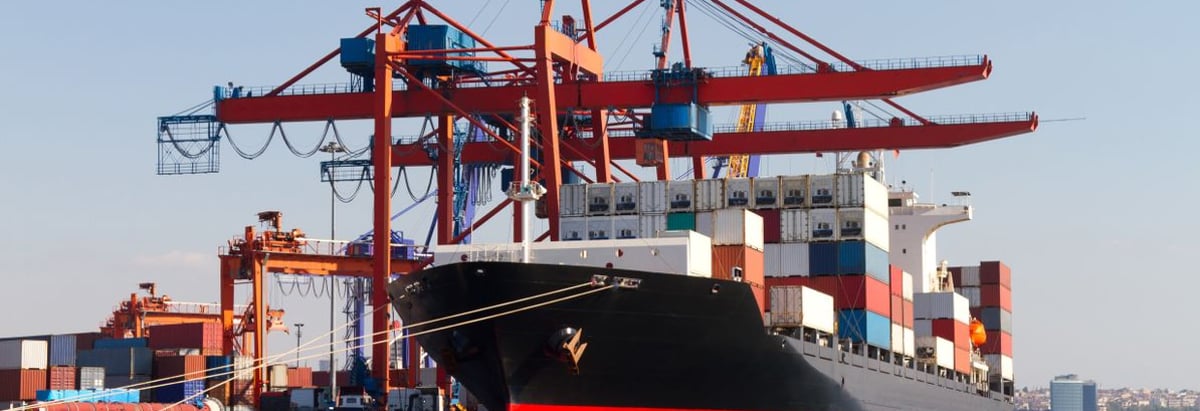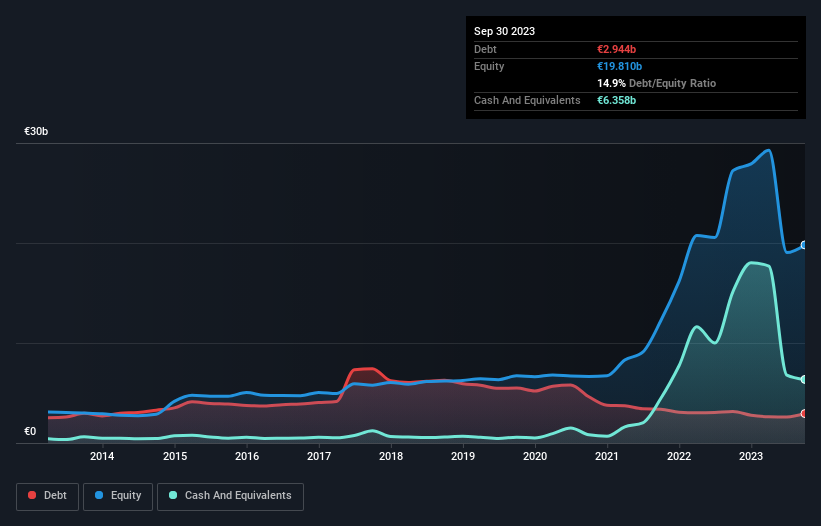
Legendary fund manager Li Lu (who Charlie Munger backed) once said, 'The biggest investment risk is not the volatility of prices, but whether you will suffer a permanent loss of capital.' So it might be obvious that you need to consider debt, when you think about how risky any given stock is, because too much debt can sink a company. We can see that Hapag-Lloyd Aktiengesellschaft (ETR:HLAG) does use debt in its business. But the more important question is: how much risk is that debt creating?
Why Does Debt Bring Risk?
Debt assists a business until the business has trouble paying it off, either with new capital or with free cash flow. If things get really bad, the lenders can take control of the business. While that is not too common, we often do see indebted companies permanently diluting shareholders because lenders force them to raise capital at a distressed price. Of course, debt can be an important tool in businesses, particularly capital heavy businesses. When we examine debt levels, we first consider both cash and debt levels, together.
Check out our latest analysis for Hapag-Lloyd
How Much Debt Does Hapag-Lloyd Carry?
You can click the graphic below for the historical numbers, but it shows that Hapag-Lloyd had €2.94b of debt in September 2023, down from €3.15b, one year before. But it also has €6.36b in cash to offset that, meaning it has €3.41b net cash.

How Healthy Is Hapag-Lloyd's Balance Sheet?
According to the last reported balance sheet, Hapag-Lloyd had liabilities of €6.06b due within 12 months, and liabilities of €4.60b due beyond 12 months. Offsetting these obligations, it had cash of €6.36b as well as receivables valued at €1.86b due within 12 months. So its liabilities outweigh the sum of its cash and (near-term) receivables by €2.45b.
Since publicly traded Hapag-Lloyd shares are worth a very impressive total of €23.7b, it seems unlikely that this level of liabilities would be a major threat. Having said that, it's clear that we should continue to monitor its balance sheet, lest it change for the worse. Despite its noteworthy liabilities, Hapag-Lloyd boasts net cash, so it's fair to say it does not have a heavy debt load!
It is just as well that Hapag-Lloyd's load is not too heavy, because its EBIT was down 66% over the last year. Falling earnings (if the trend continues) could eventually make even modest debt quite risky. The balance sheet is clearly the area to focus on when you are analysing debt. But ultimately the future profitability of the business will decide if Hapag-Lloyd can strengthen its balance sheet over time. So if you're focused on the future you can check out this free report showing analyst profit forecasts.
Finally, a company can only pay off debt with cold hard cash, not accounting profits. Hapag-Lloyd may have net cash on the balance sheet, but it is still interesting to look at how well the business converts its earnings before interest and tax (EBIT) to free cash flow, because that will influence both its need for, and its capacity to manage debt. Happily for any shareholders, Hapag-Lloyd actually produced more free cash flow than EBIT over the last three years. There's nothing better than incoming cash when it comes to staying in your lenders' good graces.
Summing Up
Although Hapag-Lloyd's balance sheet isn't particularly strong, due to the total liabilities, it is clearly positive to see that it has net cash of €3.41b. And it impressed us with free cash flow of €7.3b, being 104% of its EBIT. So we don't have any problem with Hapag-Lloyd's use of debt. There's no doubt that we learn most about debt from the balance sheet. But ultimately, every company can contain risks that exist outside of the balance sheet. To that end, you should learn about the 4 warning signs we've spotted with Hapag-Lloyd (including 2 which shouldn't be ignored) .
At the end of the day, it's often better to focus on companies that are free from net debt. You can access our special list of such companies (all with a track record of profit growth). It's free.
Valuation is complex, but we're here to simplify it.
Discover if Hapag-Lloyd might be undervalued or overvalued with our detailed analysis, featuring fair value estimates, potential risks, dividends, insider trades, and its financial condition.
Access Free AnalysisHave feedback on this article? Concerned about the content? Get in touch with us directly. Alternatively, email editorial-team (at) simplywallst.com.
This article by Simply Wall St is general in nature. We provide commentary based on historical data and analyst forecasts only using an unbiased methodology and our articles are not intended to be financial advice. It does not constitute a recommendation to buy or sell any stock, and does not take account of your objectives, or your financial situation. We aim to bring you long-term focused analysis driven by fundamental data. Note that our analysis may not factor in the latest price-sensitive company announcements or qualitative material. Simply Wall St has no position in any stocks mentioned.
About XTRA:HLAG
Flawless balance sheet with solid track record and pays a dividend.
Similar Companies
Market Insights
Community Narratives



